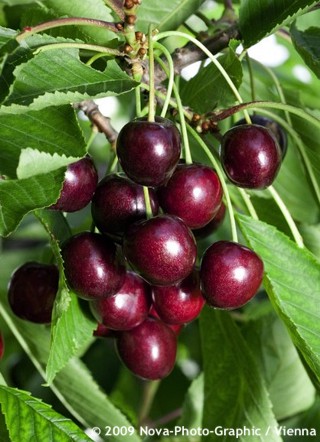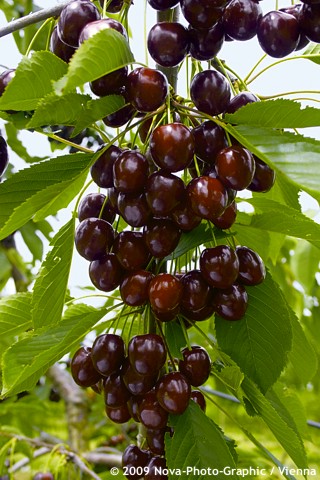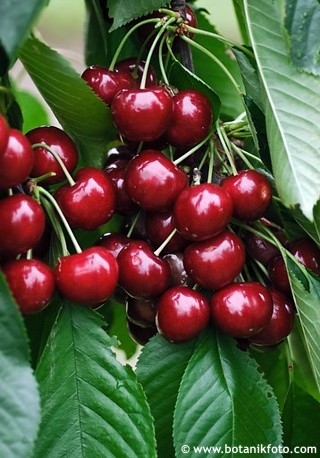Prunus avium 'MOREL' bigarreau sweet cherry – medium early – self-sterile
Prunus
The wild cherry (Prunus avium) is a native tree of Europe and western Asia, ranging from the Atlantic regions to the Caucasus, where it grows in deciduous forests on deep, well-drained soils. It belongs to the rose family (Rosaceae) and was formally described as a distinct species in the 18th century. Its origin can be traced back to refuges of the temperate zone after the last Ice Age, from where it gradually spread both naturally and with the help of humans and birds. Archaeobotanical finds even suggest that our prehistoric ancestors – including Neanderthals – may have enjoyed its small, wild fruits. Within the species there is great variability in fruit size and ripening, which became the foundation for traditional European breeding of sweet cherries.
Historically, cherries were valued since antiquity – eaten fresh, dried, preserved, or pressed into juices and wines; later, compotes and jams became common. The first systematic collections and descriptions of cultivars appeared in the 17th–19th centuries in Western Europe, especially in France and Germany, where the cherry became an iconic orchard and avenue tree. In culture, it is often linked with spring and fertility, while the European names usually derive from the Latin cerasus, although Prunus avium is the sweet cherry (in contrast to the sour cherry, Prunus cerasus). Breeding and selection focused on fruit size and firmness, balanced sweetness, regular yiled, and more recently also on resistance to spreading diseases, resulting in a wide palette of old and modern cultivars.
Morel belongs among old, dark-skinned, midseason sweet cherries of the bigarreau type. The fruits are medium to large, round, with a dark red to almost black skin. The flesh is firm, juicy, and sweet, with a clean, distinctive flavour suitable for fresh consumption as well as for preserving. Ripening occurs in late June to early July under Central European conditions, with a balanced harvest and good resistance to cracking under normal summer weather. The cultivar is self-sterile and requires pollinators flowering at the same time; reliable partners include classic mid- to late-season varieties such as ‘Hedelfingen’, ‘Schneiders Späte Knorpelkirsche’, or ‘Büttner’s’.
The tree grows moderately strongly, with an upright crown in youth that later broadens into a wider oval shape, forming solid lateral branches and tolerating formative pruning. Nevertheless, pruning cherries (and stone fruits in general) is not recommended, as large wounds heal poorly and even smaller cuts may become entry points for fungal diseases such as blossom wilt (Monilinia). The exception is formative or maintenance pruning aimed at keeping the tree smaller and accessible for harvest – this should be carried out in summer after picking, when wounds heal more readily. As for rootstocks, the most common choices are: Prunus avium seedling for long-lived, vigorous trees with deep rooting; Prunus mahaleb for drier, calcareous soils; Colt for medium-sized gardens with earlier fruiting and good winter hardiness; and Gisela 5 for smaller plantings where compact growth and early yields are desired.
Cherries require full sun, deep, fertile, and well-drained soils with a slightly acidic to neutral reaction, regular watering during dry periods, and balanced fertilisation without excess nitrogen. After planting, a strong support is essential – a single pole is sufficient for young trees and half-standards, while standards require a tripod support for at least three years. During this period, keep the soil around the roots free of grass and weeds; even later, a clean soil surface is recommended. Cherries generally develop a strong, often shallow-spreading root system that provides stability and efficient water uptake, but may disturb paving, paths, or low walls if planted too close to built structures. The cultivar is hardy to at least –29 °C, making it suitable even for colder regions of Central Europe.
Last update 22-10-2025
Goods are shipped all over Europe. For Russia and U.K. and for further details please read about SHIPPING OPTIONS HERE.
Are you interested in a serious discount for orders NOV-FEB? Check your options here.
THE PRICES INCLUDE VAT of 15%. For quick conversion you can use 1 CZK = approx. 0.04 EUR
- STANDARD QUALITY - Plants of this group are 1st class quality with number of branches and overall density adequate to their size and age, considering they were container grown.
- DE LUXE QUALITY - This label guarantees a luxurious quality of manually selected plants that, compared to their height and age, are exceptionally dense and beautiful.
- EXTRA - These plants are usually mature and bigger specimens with exceptional overall appearance.
- STANDARD (as described in the plant form) means a tree with a trunk of 190-210 cm and a crown at the top, unless specified differently. The commercial size for trees is their girth measured in the height of 1m from ground.
- HOBBY - These plants are of the same quality as our standard-quality plants but younger and therefore cheaper.
- SHRUB - a woody plant with branches growing bushy from the ground level.
- HALF-STANDARD or MINI-STANDARD - a small tree with shorter trunk, its size is usually specified.
- FEATHERED - These are trees with branches growing already from the base of the trunk and up along the stem.
- GRASSES and PERENNIALS - Sizes given usually read the diameter of the pot or the clump, as specified.






























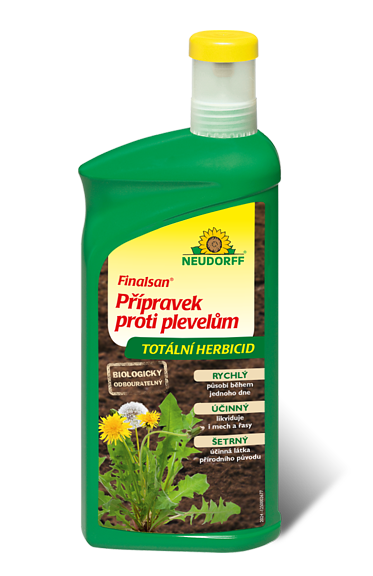


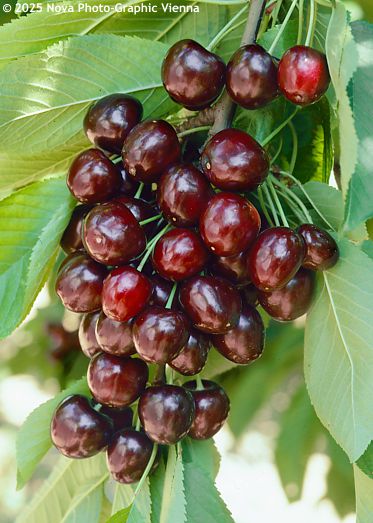
.jpg)


